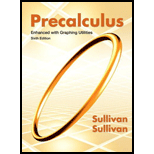
Concept explainers
To find: Instantaneous Velocity of a Ball In physics it is shown that the height of a ball thrown straight up with an initial velocity of from ground level is,
where is the elapsed time that the ball is in the air.
a. When does the ball strike the ground? That is, how long is the ball in the air?
Answer to Problem 47AYU
Solution:
a.
Explanation of Solution
Given:
Calculation:
a. The ball strike the ground when
discard the solution , the strikes the ground after .
To find: Instantaneous Velocity of a Ball In physics it is shown that the height of a ball thrown straight up with an initial velocity of from ground level is,
where is the elapsed time that the ball is in the air.
b. What is the average velocity of the ball from ?
Answer to Problem 47AYU
Solution:
b.
Explanation of Solution
Given:
Calculation:
b. The average velocity of the ball from is,
To find: Instantaneous Velocity of a Ball In physics it is shown that the height of a ball thrown straight up with an initial velocity of from ground level is,
where is the elapsed time that the ball is in the air.
c. What is the instantaneous velocity of the ball at time ?
Answer to Problem 47AYU
Solution:
c.
Explanation of Solution
Given:
Calculation:
c. The instantaneous velocity of the ball at time is the derivative : that is,
Replace . the instantaneous velocity of the ball at time is,
To find: Instantaneous Velocity of a Ball In physics it is shown that the height of a ball thrown straight up with an initial velocity of from ground level is,
where is the elapsed time that the ball is in the air.
d. What is the instantaneous velocity of the ball at ?
Answer to Problem 47AYU
Solution:
d.
Explanation of Solution
Given:
Calculation:
d. The instantaneous velocity of the ball at is,
To find: Instantaneous Velocity of a Ball In physics it is shown that the height of a ball thrown straight up with an initial velocity of from ground level is,
where is the elapsed time that the ball is in the air.
e. When is the instantaneous velocity of the ball equal to zero?
Answer to Problem 47AYU
Solution:
e.
Explanation of Solution
Given:
Calculation:
e. The instantaneous velocity of the ball is zero when,
To find: Instantaneous Velocity of a Ball In physics it is shown that the height of a ball thrown straight up with an initial velocity of from ground level is,
where is the elapsed time that the ball is in the air.
f. How high is the ball when its instantaneous velocity equals zero?
Answer to Problem 47AYU
Solution:
f.
Explanation of Solution
Given:
Calculation:
f. How high is the ball when its instantaneous velocity equals zero.
The instantaneous velocity of the ball is zero when,
To find: Instantaneous Velocity of a Ball In physics it is shown that the height of a ball thrown straight up with an initial velocity of from ground level is,
where is the elapsed time that the ball is in the air.
g. What is the instantaneous velocity of the ball when it strikes the ground?
Answer to Problem 47AYU
Solution:
g.
Explanation of Solution
Given:
Calculation:
g. The ball strikes the ground when , the instantaneous velocity when is,
The velocity of the ball at is , the negative value implies that the ball is travelling downward.
Chapter 14 Solutions
Precalculus Enhanced with Graphing Utilities
Additional Math Textbook Solutions
Calculus, Single Variable: Early Transcendentals (3rd Edition)
Precalculus (10th Edition)
University Calculus: Early Transcendentals (3rd Edition)
Precalculus: Concepts Through Functions, A Unit Circle Approach to Trigonometry (4th Edition)
Single Variable Calculus: Early Transcendentals (2nd Edition) - Standalone book
 Calculus: Early TranscendentalsCalculusISBN:9781285741550Author:James StewartPublisher:Cengage Learning
Calculus: Early TranscendentalsCalculusISBN:9781285741550Author:James StewartPublisher:Cengage Learning Thomas' Calculus (14th Edition)CalculusISBN:9780134438986Author:Joel R. Hass, Christopher E. Heil, Maurice D. WeirPublisher:PEARSON
Thomas' Calculus (14th Edition)CalculusISBN:9780134438986Author:Joel R. Hass, Christopher E. Heil, Maurice D. WeirPublisher:PEARSON Calculus: Early Transcendentals (3rd Edition)CalculusISBN:9780134763644Author:William L. Briggs, Lyle Cochran, Bernard Gillett, Eric SchulzPublisher:PEARSON
Calculus: Early Transcendentals (3rd Edition)CalculusISBN:9780134763644Author:William L. Briggs, Lyle Cochran, Bernard Gillett, Eric SchulzPublisher:PEARSON Calculus: Early TranscendentalsCalculusISBN:9781319050740Author:Jon Rogawski, Colin Adams, Robert FranzosaPublisher:W. H. Freeman
Calculus: Early TranscendentalsCalculusISBN:9781319050740Author:Jon Rogawski, Colin Adams, Robert FranzosaPublisher:W. H. Freeman
 Calculus: Early Transcendental FunctionsCalculusISBN:9781337552516Author:Ron Larson, Bruce H. EdwardsPublisher:Cengage Learning
Calculus: Early Transcendental FunctionsCalculusISBN:9781337552516Author:Ron Larson, Bruce H. EdwardsPublisher:Cengage Learning





